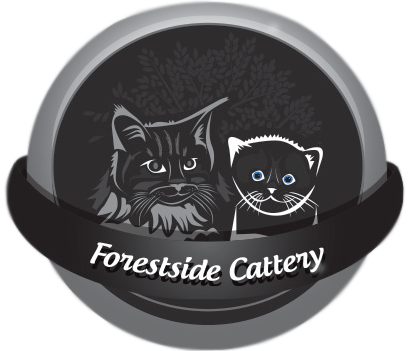Maine Coons are the largest breed of domestic cat. Males weigh from 15 to 25 lb (6.8 to 11.3 kg) with females weighing from 10 to 15 lb (4.5 to 6.8 kg). The height of adults can vary between 10 and 16 in (25 and 41 cm) and they can reach a length of up to 48 in (120 cm), including the tail, which can reach a length of 14 in (36 cm) and is long, tapering, and heavily furred, almost resembling a raccoon’s tail. The body is solid and muscular, which is necessary for supporting their own weight, and the chest is broad. Maine Coons possess a rectangular body shape and are slow to physically mature; their full potential size is normally not reached until they are three to five years old, while other cats take about only one year You may have heard tell of 15kg! behemoths, but any Maine Coon that reaches that size is probably grossly overweight.
The Maine Coon is a longhaired, or medium-haired, cat. The coat is soft and silky, although texture may vary with coat color. The length is shorter on the head and shoulders, and longer on the stomach and flanks with some cats having a lion-like ruff around their neck. Minimal grooming is required for the breed, compared to other long-haired breeds, as their coat is mostly self-maintaining owing to a light-density undercoat. The coat is subject to seasonal variation, with the fur being thicker in the winter and thinner during the summer.
Maine Coons can have any colors that other cats have. Colors indicating hybridization, such as chocolate, lavender, the Siamese pointed patterns or the “ticked” patterns, are not accepted by some breed standards (the ‘ticked’ pattern, for example, is accepted by TICA). The most common pattern seen in the breed is brown tabby. All eye colors are accepted under breed standards, with the exception of the occurrence of blue-colored or odd-eyes (i.e. two eyes of different colors) in cats possessing coat colors other than white.
Maine Coons have several physical adaptations for survival in harsh winter climates. Their dense water-resistant fur is longer and shaggier on their underside and rear for extra protection when they are walking or sitting on top of wet surfaces of snow or ice. Their long and bushy raccoon-like tail is resistant to sinking in snow, and can be curled around their face and shoulders for warmth and protection from wind and blowing snow and it can even be curled around their backside like an insulated seat cushion when sitting down on a snow or ice surface. Large paws, and especially the extra-large paws of polydactyl Maine Coons, facilitate walking on snow and are often compared to snowshoes. Long tufts of fur growing between their toes help keep the toes warm and further aid walking on snow by giving the paws additional structure without significant extra weight. Heavily furred ears with extra long tufts of fur growing from inside help keep their ears warm
While Maine Coons are highly people-oriented cats, they are not overly-dependent. They do not constantly pester you for attention, but prefer to “hang out” with their owners, investigating whatever activity you’re involved in and “helping” when they can. They are not, as a general rule, known as “lap cats” but as with any personality trait there are a few Maine Coons that prefer laps. Most Maine Coons will stay close by, probably occupying the chair next to yours instead. Maines will follow you from room to room and wait outside a closed door for you to emerge. A Maine Coon will be your companion, your buddy, your pal, but hardly ever your baby.
Maine Coons are relaxed and easy-going in just about everything they do. The males tend to be the clowns while the females retain more dignity, but both remain playful throughout their lives. They generally get along well with kids and dogs, as well as other cats. They are not as vertically-oriented as some other breeds, prefering to chase objects on the ground and grasping them in their large paws — no doubt instincts developed as professional mousers. Many Maine Coons will play “fetch” with their owners.
